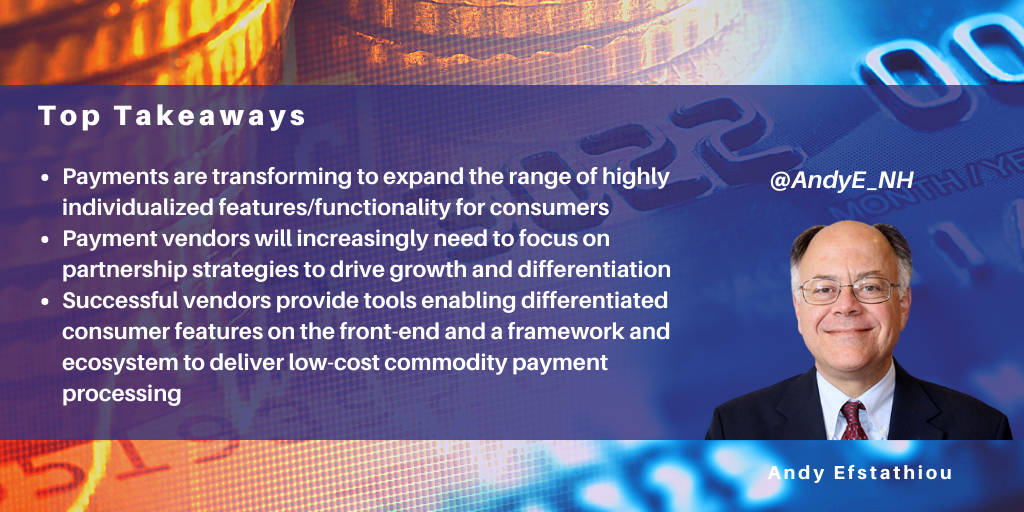Search posts by keywords:
Filter posts by author:
Related NEAT Reports
Other blog posts
posted on Oct 27, 2021 by Andy Efstathiou

The payments industry has been transforming away from physical payments and electronic closed networks into an open network, all-digital payment ecosystem, and the pandemic has accelerated this shift. From the consumer’s perspective, this has been characterized by:
- A move to e-commerce and m-commerce, away from brick-and-mortar commerce
- Aggressively reduced use of traditional payment types (e.g., cash and checks) and increased use of digital payments (e.g., digital wallets, phone payments)
- Hyper-personalized payment experiences (e.g., enabled by multiple channel access and AI).
In this environment, payments vendors are expanding their:
- Customer bases to cover all consumer demographics
- Modes of payment, providing access from one interface
- Use of AI and biometrics
- Payment functionality to include real-time, cloud delivery, APIs, and platform-based solutions.
The payments industry is adopting key emerging functionality including:
- Buy now, pay later (BNPL) which combines credit and payment functions into one financial product
- Biometric payments, increasing security effectiveness and reducing friction from password usage
- Cryptocurrency payment options which expand the range of currency options
- Invisible payments: payments via a virtual wallet, increasing the ease and security of payments.
The Challenge
New competitors and new functionality are disrupting the traditional payments business, driving down margins. A recent Capgemini survey found that 70% of bank executives stated their payments business was either unprofitable or at break-even. Banks need to adapt their payments business to compete with emerging payments vendors.
Banks have three levers available to them to improve payment profitability:
- Change their business model, where there are two options available:
- Exit unprofitable offerings, reducing the overall offering set
- Partner with third parties to expand the offering set by geography and functionality
- Change their operating model, with two models available:
- Creating partnerships to invest in creating new offerings for the market
- Building ecosystems and API sets to let customers select new offerings from the bank’s platform
- Change their technology used in operations delivery, where the three models available are:
- Invest in cost-reducing technology: used by global tier one banks to create differentiation and reduce cost
- Buy operations delivery on an as-a-service basis: used by banks to support short-cycle products, seasonal/cyclical products, and untested products
- Collaborate with technology product vendors to build offerings and improve the distribution of the products with joint customer propositions.
The focus of these initiatives is reduced cost of delivery, but customers do not buy payments to improve banking profitability. They buy to improve their own experience. The key parts of the payments value chain delivering differentiation are the front end (i.e., signup, underwriting, acceptance, ease of use, speed of execution, and customization) and reporting (i.e., receipts, integration to tax reporting, analytics, budgeting, and customization).
Capgemini’s Approach
Delivering this level of change, while standardizing operations to control and reduce cost requires a move to standardized core platforms with a high degree of configurability to adapt to specific markets, customers, and a constantly changing environment. Capgemini’s approach demonstrates how this strategy can be implemented. Key components of its payments offerings include:
- Clearing Connect: a consolidated payment hub solution that can be customized for each clearing house the bank operates in. The payment hub allows centralized processing of payments but enables rapid customization and enablement of additional clearing houses as the client requires
- Payments Realization COE Hub: a COE that supports banks' modernization of their payments infrastructure and operations. There are three key offerings:
- Focused engines as payment hubs: Capgemini partners with solution vendors to provide products and services to modernize the operation of a payment. This represents 55% of client demand
- Frameworks: provides insights and a structured approach to payment transformation (35% of client demand)
- As-a-service: provides an emerging payments wallet in Europe, in partnership with AWS (10% of client demand).
These offerings enable banks to build a core payments platform that can be rapidly adapted to changing markets, technologies, and regulations.
Conclusions
The payments market is facing compressing margins and expanding functionality. Payment providers need to be able to expand their differentiated services with highly individualized features/functionality for consumers. At the same time, undifferentiated processing services must reduce costs to remain viable. The solution is for payments vendors to build standardized core payment hubs which can rapidly be adapted to new clearing houses and financial product introductions.
Capgemini has built services that provide a framework and ecosystem for transformation and a core processing hub that can deliver low-cost commodity payment processing. As the market evolves, payment vendors will increasingly need to focus on partnership strategies to drive growth and differentiation.
